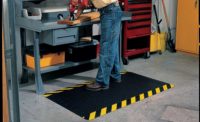Studies show that older workers are more susceptible to negative consequences from heat exposure, and building this understanding into a workplace heat illness prevention program is imperative to creating a robust plan.
OSHA does not have a standard specific to employee exposure to excessive temperatures, either hot or cold. Employers are responsible for furnishing their employees “employment and a place of employment which are free from recognized hazards that are causing or likely to cause death or serious physical harm…” as stated in the General Duty Clause of the OSH Act of 1970. OSHA has used the General Duty Clause to cite employers who have allowed employees to be exposed to serious physical harm from excessively hot work environments.
Our aging workforce
BLS statistics show that in 1990 workers who were age 55 or older made up 12 percent of the working population. By 2010 workers 55 and up made up 19.5 percent of the total. And BLS predicts by 2020, this group will comprise 25.2 percent of our workforce.
Getting sluggish
NIOSH released its updated Criteria for a Recommended Standard: Occupational Exposure to Heat and Hot Environments, in February, 2016. The executive summary states: “Those over the age of 60 are at additional risk for suffering from heat disorders.”
According to research, “The aging process results in a more sluggish response of the sweat glands, which leads to a less effective control of the body temperature in the sedentary individual. Aging also results in a decreased level of skin blood flow associated with exposure to heat… the decrease in skin blood flow implies an impaired thermoregulatory mechanism, possibly related to the reduced efficiency of the sympathetic nervous system.”
The report also presented learnings from two studies of miners. One study¹ looked at two groups of coal miners in the U.S. One group’s average age was 27 and the other’s was 47. There was little difference in physiological responses between the groups during cool or comfortable conditions, but in hotter conditions the older group of workers exhibited more thermoregulatory strain as well as lower aerobic work capacities.
A second study² looked at five years’ worth of heat stroke records from South African gold mines. Miners over 40 years of age made up less than 10 percent of the mining population but accounted for half of the fatal cases and a quarter of the nonfatal cases of heat stroke.
OSHA guidance
OSHA offers guidance for employers on its Heat Illness Prevention resource page. Here OSHA identifies the core components of a heat illness prevention program. The program should, “provide workers with water, rest and shade; gradually increase workloads and allow more frequent breaks for new workers or workers who have been away for a week or more to build a tolerance for working in the heat (acclimatization); modify work schedules as necessary; plan for emergencies and train workers about the symptoms of heat-related illnesses and their prevention; and monitor workers for signs of illness.”
Keping hydrated
NIOSH’s report offers some more specifics. For hydration, NIOSH recommends that drinkable water at a temperature of less than 59 degrees Fahrenheit be made accessible near the employees work area. Employees working in the heat for less than two hours and involved in moderate work activities should drink eight ounces of water every 15-20 minutes. During prolonged sweating lasting several hours, they should drink sports drinks containing balanced electrolytes. If a sports drink is used, the percentage by volume of electrolytes/carbohydrates should not exceed eight percent.
When providing sports beverages for employees keep in mind possible pre-existing health issues, such as hypertension and diabetes -- conditions associated with aging. Some sports drinks are sugar-free with low sodium. Still, individuals who have these conditions should review the product’s ingredient statement with their physicians prior to consumption. Water may be the only hydration option for some.
Acclimatization
OSHA recommends that new workers and those returning from a prolonged absence should begin with 20 percent of the workload on the first day, increasing by no more than 20 percent each following day.
“Full acclimatization may take up to 14 days or longer depending on factors related to the individual such as an increased risk of heat illness due to certain medications or medical conditions, or the environment,” according to OSHA. NIOSH indicates that acclimatization for a “non-physically fit individual” may take 50 percent longer than the time required for a physically fit peer. Being in less than optimal fitness are not traits exclusive to older workers, but they’re more common in older individuals. Older workers may require longer acclimatization periods than younger workers.
Monitoring workers is a component of OSHA’s heat illness plan where age could draw closer scrutiny. In its criteria for a recommended standard, NIOSH addresses the importance of preplacement medical evaluations for workers who will be exposed to hot environments. One step of the evaluation would be a physical examination, where “candidates… over 50 years of age or those younger than 50 years of age with underlying cardiac risk factors may need to have additional testing (e.g., electrocardiogram ( ECG) with interpretation by cardiologist).” This isn’t a requirement but what NIOSH is proposing based upon their research.
Summary
As our workforce continues to age, you’ll need to regularly review all aspects of your safety and health programs from a slightly different perspective. The way older workers respond to elevated temperatures is just one example of how you may need to shift your thinking. Sometimes it’s not new or altered tasks that create potential safety concerns, but rather the physiological changes occurring within our workers as they age that necessitate adjustments to safety and health programs.
Sources
¹ NIOSH [2016]. NIOSH criteria for a recommended standard: occupational exposure to heat and hot environments. By Jacklitsch B, Williams WJ, Musolin K, Coca A, Kim J-H, Turner N. Cincinnati, OH: U.S. Department of Health and Human Services, Centers for Disease Control and Prevention, National Institute for Occupational Safety and Health, DHHS (NIOSH) Publication 2016-106. DHHS (NIOSH) Publication No. 2016-106. February 2016. 33.
²NIOSH [2016]. 35.



